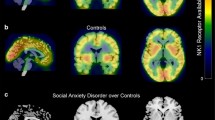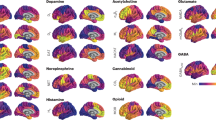Abstract
We examined the contribution of 5-HT1A autoreceptors (with [11C]WAY100635 positron emission tomography) to amygdala reactivity (with blood oxygenation level–dependent functional magnetic resonance imaging) in 20 healthy adult volunteers. We found a significant inverse relationship wherein 5-HT1A autoreceptor density predicted a notable 30–44% of the variability in amygdala reactivity. Our data suggest a potential molecular mechanism by which a reduced capacity for negative feedback regulation of 5-HT release is associated with increased amygdala reactivity.

Similar content being viewed by others
References
Lemonde, S. et al. J. Neurosci. 23, 8788–8799 (2003).
Parsey, R.V. et al. Biol. Psychiatry 59, 106–113 (2006).
Blier, P. & de Montigny, C. Neuropsychopharmacology 21, 91S–98S (1999).
Hasler, G., Drevets, W.C., Manji, H.K. & Charney, D.S. Neuropsychopharmacology 29, 1765–1781 (2004).
Parks, C.L., Robinson, P.S., Sibille, E., Shenk, T. & Toth, M. Proc. Natl. Acad. Sci. USA 95, 10734–10739 (1998).
Klemenhagen, K.C., Gordon, J.A., David, D.J., Hen, R. & Gross, C.T. Neuropsychopharmacology 31, 101–111 (2006).
Arborelius, L. IDrugs 2, 121–128 (1999).
Lemonde, S., Du, L., Bakish, D., Hrdina, P. & Albert, P.R. Int. J. Neuropsychopharmacol. 7, 501–506 (2004).
LeDoux, J.E. Annu. Rev. Neurosci. 23, 155–184 (2000).
David, S.P. et al. J. Neurosci. 25, 2586–2590 (2005).
Caspi, A. et al. Science 301, 386–389 (2003).
Hariri, A.R. et al. Science 297, 400–403 (2002).
Acknowledgements
We thank S. Hulland, S. Brown and J. James for technical assistance. This work was supported by grants from the National Institute of Mental Health (MH072837 to A.R.H., and MH067602 and MH64625 to C.C.M.) and from the National Alliance for Research on Schizophrenia and Depression (Young Investigator Award to A.R.H.).
Author information
Authors and Affiliations
Contributions
A.R.H. designed the study as a component of a parent study directed by C.C.M. P.M.F. and S.K.Z. performed the phenotype assessment. E.L.M.-K., C.C.M. and S.L.B. contributed to subject assessment, recruitment and data collection. A.R.H., P.M.F., J.C.P. and S.K.Z. participated in data analysis and interpretation. All authors reviewed and approved the final manuscript.
Corresponding author
Ethics declarations
Competing interests
The authors declare no competing financial interests.
Supplementary information
Rights and permissions
About this article
Cite this article
Fisher, P., Meltzer, C., Ziolko, S. et al. Capacity for 5-HT1A–mediated autoregulation predicts amygdala reactivity. Nat Neurosci 9, 1362–1363 (2006). https://doi.org/10.1038/nn1780
Received:
Accepted:
Published:
Issue Date:
DOI: https://doi.org/10.1038/nn1780
- Springer Nature America, Inc.
This article is cited by
-
Association between brain serotonin 4 receptor binding and reactivity to emotional faces in depressed and healthy individuals
Translational Psychiatry (2023)
-
The Serotonin 1A (5-HT1A) Receptor as a Pharmacological Target in Depression
CNS Drugs (2023)
-
Application of positron emission tomography in psychiatry—methodological developments and future directions
Translational Psychiatry (2022)
-
Large-scale network dynamics in neural response to emotionally negative stimuli linked to serotonin 1A binding in major depressive disorder
Molecular Psychiatry (2021)
-
Expression and co-expression of serotonin and dopamine transporters in social anxiety disorder: a multitracer positron emission tomography study
Molecular Psychiatry (2021)





